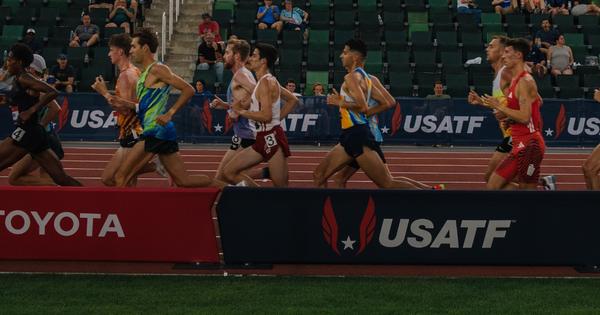By David Melly
November 19, 2025
Sure, it’s a quiet time for professional track and field. There aren’t many meets on the calendar, and virtually all the top athletes are in deep postseason hibernation. But nothing gets the fans engaged like some breaking news on everyone’s favorite topic: tax filings.
Don’t unsubscribe! This is important stuff. Because USA Track and Field is a tax-exempt nonprofit organization, every year they have to tell the IRS—and us, the public—how they’ve been making and spending their money over the past year. Don’t worry; we read the forms so you don’t have to, and here’s what you need to know:
This week, USATF reported, alongside a bunch of other information, that the organization generated record revenue in 2024. Hooray! Regardless of your personal feelings about Max Siegel, the board of directors, or the organization in general, it’s inarguably a good thing for American track and field fans that the governing body is making more money this year than the year before. Investing in the good things we all like—hosting high-quality domestic meets, direct athlete support, and sending full teams to championships, to name a few—isn’t possible if USATF has no money. So hearing that the organization brought in $44.6 million in the calendar year 2024, a 22% increase over 2023, is a surface-level takeaway we can all celebrate.
Now, here’s where we bring things back down to earth. USATF’s expenses still exceeded its revenue, which happens pretty much every year but was greatly exacerbated by the costs of hosting the 2022 World Championships. Currently, the organization is sitting on a total deficit of roughly $6 million, $1.2 million of which was added this year. That’s not a huge worry for an organization of USATF’s size and scale, but it’s one of those things that can become a huge worry over time if the trend of slightly outspending your income continues.
Promotional sponsorships from companies like Toyota and Nike make up a significant chunk of USATF’s revenue every year. Those numbers didn’t change much, which pretty much confirms what we already know: track and field didn’t become a wildly more valuable advertising space in 2024, and USATF didn’t bring in any new big-name corporate heavyweights. What did grow significantly was revenue from events ($1.3 million to $6.2 million) and memberships ($3.9 million to $5.4 million). The big former jump likely comes primarily from the U.S. Olympic Trials: it’s a lot more lucrative to host a ten-day championship in an Olympic year than a four-day version of USAs in a Worlds year. A full-session pass to last year’s Hayward festivities was over $400, with single-day tickets costing more per session. And the cost of a USATF membership has more than doubled since 2021, growing from $32 per year to $65 if you want to re-up for 2026.
So here’s one way to look at it: you, dear reader, are doing a lot to keep USATF afloat! The organization’s path toward revenue growth appears to rely heavily on getting track and field participants and fans to pay for services and experiences. As member fees and ticket prices, like pretty much everything else in the world right now, continue to swell, an important question for us as consumers of USATF’s offerings should be: does the product we receive in return reflect the added value we’re putting in? Because that trend is not reversing any time soon.
The news earlier this year that the 2025 NYC and LA Grand Prix-es would be cancelled will have ripple effects on next year’s tax report. There probably won’t be any bombshell revelations there, however. The simple fact that the meets got cancelled likely means that they weren’t generating much revenue to begin with, or at the very least that revenue came nowhere close to balancing out the expense of running the two meets.
So how else are your hard-earned dollars being spent? In the past, USATF CEO Max Siegel’s compensation structure has been the source of much scrutiny. Again, there’s a mixed bag to report here: Siegel is still making seven figures, but his salary actually decreased relative to 2023, from $1.17 million to $1.13 million. Organizational salary costs increased by around 11%, from $9.5 million to $10.5 million. Among the ten highest paid employees, no one else’s salary changed wildly, and generally speaking, staff costs accounting for less than a quarter of overall expenses is a fairly good ratio for nonprofits of this size.
All in all, this news paints the picture of an organization that’s not headed in a wildly positive direction, but not a wildly negative one either. What it likely means for the future is that USATF will be laser-focused on putting on revenue-generating events while keeping costs as low as possible, and there’s one big one coming up soon to keep an eye on: the World Cross Country Championships in Tallahassee on January 10. The success of that event will set the tone for the year. With no Olympic or World Championship on the track, USATF can’t afford—literally—for fans/customers to treat 2026 like a “down year.” Let’s hope for all our sakes they put together a calendar that’s well worth your time and your dollar.

David Melly
David began contributing to CITIUS in 2018, and quickly cemented himself as an integral part of the team thanks to his quick wit, hot takes, undying love for the sport and willingness to get yelled at online.




